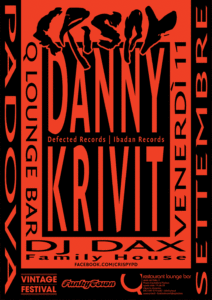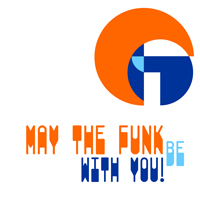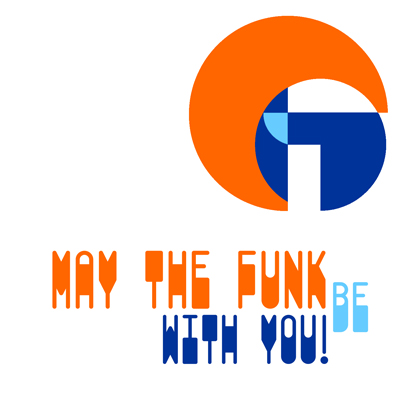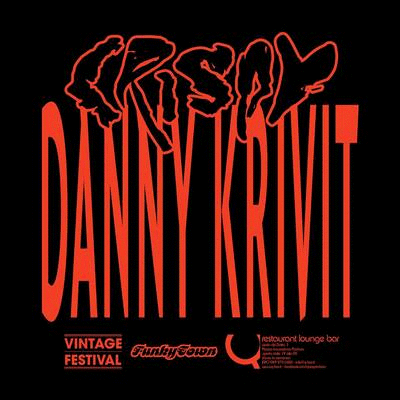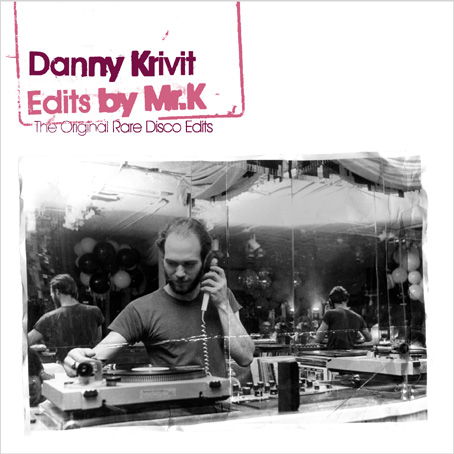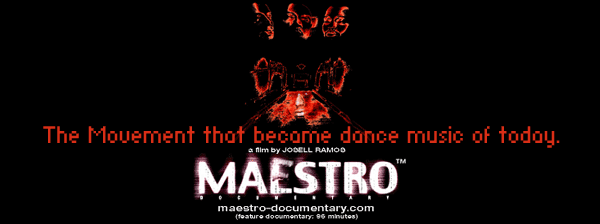EDITS BY MR. K STRUT
The Original Rare Disco Mixes Edits by Mr. K (Year2003)
1. Diana Ross – No One Gets The Prize (Re-edited Jimmy Simpson remix)
2. Caress – Catch The Rhythm
3. Cymande – Bra
4. Betty Wright – Where Is The Love
5. LTD – Love To The World
6. Ecstasy Passion and Pain – Ask Me (Re-worked)
7. Lenny Williams – You Got Me Runnin’ (Breakdown Edit)
8. Sly & The Family Stone – Dance To The Music (Medley)
9. The Sisters Love – Give Me Your Love
10a. Genie Brown – I Can’t Stop Talking
10b. Tribe – Koke
This unrivalled collection, paired with years of experience behind the decks of New York clubs as varied as The Roxy, playing hip hop alongside D.ST, Red Alert, and Bambaataa, or guesting at the Paradise Garage alongside Larry Levan, rightfully places Danny up there as one of the world’s elite, truly able to play out that DJ cliché of ‘taking people on a journey’ with epic sets spanning up to seventeen hours.
The latest generation of successful DJs and producers are a significantly different breed. Today’s DJ will play short two hour sets from a box of the latest big tunes and producers will make tracks that might never leave the confines of their computer’s hard drive. It’s a world away from the analogue beginnings of dance music.
“You’re taking a puzzle. Parts that someone else did and you’re re-arranging those parts, you’re using some parts and not using others.” Executed well, the resulting “remix” produced a song that would keep people dancing harder and for longer than the original version.
With this album, ‘Edits by Mr. K’, Strut presents ten of the best edits from Danny’s archive, spanning 1983 to the present day. All are gems of their time and reflect his expertise both in the studio and his experience of what works on the dancefloor. But, despite the acclaim his work has received over the years, the early transition from successful DJ to successful ”remixer” was far from easy.
DJ Booth to studio
“My first remix was for Sleeping Bag Records. It was very disappointing. The session was more than 50% wasted time with the engineer saying, ‘We can fix that in editing’ but it was soon clear that he couldn’t edit. At this point I couldn’t edit either but I did know what a bad edit was! Soon after that I did a remix for another small label and déjà vu! The same thing happened again & most of the session was wasted. By now I had learnt how to edit, but only in theory. I knew I couldn’t do any worse than this guy but I just didn’t have the nerve to jump in & fix it.
“I’d heard a lot of other edits by DJs like Francois Kevorkian and Walter Gibbons but I didn’t think I was in the same league. These two frustrating mixes were the push I needed to start playing around and try ideas.
“I had a reel to reel as, back then, it was fairly standard equipment. If you wanted to record, there were no DAT tapes or CDs. It was cassette or reel to reel. Even back then cassettes were a little dodgy – you couldn’t call cassettes a master. But a reel to reel was a master of something, whether it was music that wasn’t released or a mix that you had done. People would also use the reel to reel as an effects box. We didn’t have these little silver Pioneer effects boxes, so you’d use the reel to reel as an echo chamber. That was very common.”
Editing Influences
“In a disco you can make very abrupt changes and somehow feel you’ve segued people into that, or feel they can move with that change. What I learnt from DJ-ing at the roller rink is how important the groove is. I like to keep to a groove, not to be monotonous, but to take you on a trip. Beat on beat mixing without paying attention to the groove can really break people’s mood.
The artists on editing
“I have spoken with a couple of artists and it’s a mixed bag. When it comes to classic records, they’re usually already in a situation where they’re not seeing any royalties. Sometimes they even appreciate the fact that somebody liked it enough to give it a second life. I generally work with a lot of artists that have been forgotten so it’s not like I’m re-working Sade or Prince. I’m doing stuff that’s quite obscure and forgotten about and companies don’t give it the time of day, even in their reissue series. When I spoke to Vince Montana, he was just flattered that I might be doing something like that, but at the same time he was saying, ‘Well, if it’s worth doing, how come I don’t do that?’ At least he was in a situation to be able to do it – many people aren’t that lucky.
“The other side of it is that I’m not bastardising these things, I’m not tearing them apart with a different track and saying that the original was OK but this is completely different, & better! I’m only working on songs that I liked from the start. I’m not messing with the vocals or getting rid of things. I try to complement it by only altering it slightly, really just extending it.”
Legitimate releases
“Since the ’80s, a bunch of these versions have become legitimate. I remember in particular when I would give Francois one of these edits he would say, “Oh this is really bad, you shouldn’t do this.” And I would say, “I only edited it. If you don’t want it, don’t take it.” But I was soon getting legitimate work from them. In ’86 I was given several projects from PolyGram, I worked on ‘Touch & Go’ (Ecstacy, Passion & Pain) from Sunnyview, Nuphonic put out ‘Love Is The Message’ and Salsoul (Unidisc) put out ‘Salsoul Rainbow’ and ‘Runaway’ (Salsoul Orchestra). Most recently, Ibadan released my versions of ‘Rock Steady’ (Aretha Franklin) and ‘Sultana’ (Titanic) and Strut’s ‘Grass Roots’ compilation and 12”s featured several edits and gave out a clear picture of my personal taste & what I’m about.”
Reel to Reel vs Computers
“Lots of times I would make a mistake, putting the wrong piece in backwards or in the wrong place and it turns into an idea. A good example was with ‘Let’s Start The Dance’ in ‘Rock The House’ with a couple of mistake edits in it that sound really interesting. I thought, ‘Hey that works’, so you run in to interesting things with tape that you might not with a computer.
“I started using computers about two years ago. I completely appreciate computers. The sound quality of a reel to reel is excellent but once you start handling a tape more than a couple of times you start to hear a quality loss. Reel to reels are also very touchy and hard to maintain. I feel the computer is very dependable and there’s so much more manipulation available with the effects. At this level it’s still not remixing, but you can add a little post-production.
Simon Haggis, December 2002.
THNX to Simon Haggis, Toni Rossano www.strut.co.uk STRUT
The Original Rare Disco Mixes Edits by Mr. K
1. Diana Ross – No One Gets The Prize (Re-edited Jimmy Simpson remix)
2. Caress – Catch The Rhythm
3. Cymande – Bra
4. Betty Wright – Where Is The Love
5. LTD – Love To The World
6. Ecstasy Passion and Pain – Ask Me (Re-worked)
7. Lenny Williams – You Got Me Runnin’ (Breakdown Edit)
8. Sly & The Family Stone – Dance To The Music (Medley)
9. The Sisters Love – Give Me Your Love
10a. Genie Brown – I Can’t Stop Talking
10b. Tribe – Koke
This unrivalled collection, paired with years of experience behind the decks of New York clubs as varied as The Roxy, playing hip hop alongside D.ST, Red Alert, and Bambaataa, or guesting at the Paradise Garage alongside Larry Levan, rightfully places Danny up there as one of the world’s elite, truly able to play out that DJ cliché of ‘taking people on a journey’ with epic sets spanning up to seventeen hours.
The latest generation of successful DJs and producers are a significantly different breed. Today’s DJ will play short two hour sets from a box of the latest big tunes and producers will make tracks that might never leave the confines of their computer’s hard drive. It’s a world away from the analogue beginnings of dance music.
“You’re taking a puzzle. Parts that someone else did and you’re re-arranging those parts, you’re using some parts and not using others.” Executed well, the resulting “remix” produced a song that would keep people dancing harder and for longer than the original version.
With this album, ‘Edits by Mr. K’, Strut presents ten of the best edits from Danny’s archive, spanning 1983 to the present day. All are gems of their time and reflect his expertise both in the studio and his experience of what works on the dancefloor. But, despite the acclaim his work has received over the years, the early transition from successful DJ to successful ”remixer” was far from easy.
DJ Booth to studio
“My first remix was for Sleeping Bag Records. It was very disappointing. The session was more than 50% wasted time with the engineer saying, ‘We can fix that in editing’ but it was soon clear that he couldn’t edit. At this point I couldn’t edit either but I did know what a bad edit was! Soon after that I did a remix for another small label and déjà vu! The same thing happened again & most of the session was wasted. By now I had learnt how to edit, but only in theory. I knew I couldn’t do any worse than this guy but I just didn’t have the nerve to jump in & fix it.
“I’d heard a lot of other edits by DJs like Francois Kevorkian and Walter Gibbons but I didn’t think I was in the same league. These two frustrating mixes were the push I needed to start playing around and try ideas.
“I had a reel to reel as, back then, it was fairly standard equipment. If you wanted to record, there were no DAT tapes or CDs. It was cassette or reel to reel. Even back then cassettes were a little dodgy – you couldn’t call cassettes a master. But a reel to reel was a master of something, whether it was music that wasn’t released or a mix that you had done. People would also use the reel to reel as an effects box. We didn’t have these little silver Pioneer effects boxes, so you’d use the reel to reel as an echo chamber. That was very common.”
Editing Influences
“In a disco you can make very abrupt changes and somehow feel you’ve segued people into that, or feel they can move with that change. What I learnt from DJ-ing at the roller rink is how important the groove is. I like to keep to a groove, not to be monotonous, but to take you on a trip. Beat on beat mixing without paying attention to the groove can really break people’s mood.
The artists on editing
“I have spoken with a couple of artists and it’s a mixed bag. When it comes to classic records, they’re usually already in a situation where they’re not seeing any royalties. Sometimes they even appreciate the fact that somebody liked it enough to give it a second life. I generally work with a lot of artists that have been forgotten so it’s not like I’m re-working Sade or Prince. I’m doing stuff that’s quite obscure and forgotten about and companies don’t give it the time of day, even in their reissue series. When I spoke to Vince Montana, he was just flattered that I might be doing something like that, but at the same time he was saying, ‘Well, if it’s worth doing, how come I don’t do that?’ At least he was in a situation to be able to do it – many people aren’t that lucky.
“The other side of it is that I’m not bastardising these things, I’m not tearing them apart with a different track and saying that the original was OK but this is completely different, & better! I’m only working on songs that I liked from the start. I’m not messing with the vocals or getting rid of things. I try to complement it by only altering it slightly, really just extending it.”
Legitimate releases
“Since the ’80s, a bunch of these versions have become legitimate. I remember in particular when I would give Francois one of these edits he would say, “Oh this is really bad, you shouldn’t do this.” And I would say, “I only edited it. If you don’t want it, don’t take it.” But I was soon getting legitimate work from them. In ’86 I was given several projects from PolyGram, I worked on ‘Touch & Go’ (Ecstacy, Passion & Pain) from Sunnyview, Nuphonic put out ‘Love Is The Message’ and Salsoul (Unidisc) put out ‘Salsoul Rainbow’ and ‘Runaway’ (Salsoul Orchestra). Most recently, Ibadan released my versions of ‘Rock Steady’ (Aretha Franklin) and ‘Sultana’ (Titanic) and Strut’s ‘Grass Roots’ compilation and 12”s featured several edits and gave out a clear picture of my personal taste & what I’m about.”
Reel to Reel vs Computers
“Lots of times I would make a mistake, putting the wrong piece in backwards or in the wrong place and it turns into an idea. A good example was with ‘Let’s Start The Dance’ in ‘Rock The House’ with a couple of mistake edits in it that sound really interesting. I thought, ‘Hey that works’, so you run in to interesting things with tape that you might not with a computer.
“I started using computers about two years ago. I completely appreciate computers. The sound quality of a reel to reel is excellent but once you start handling a tape more than a couple of times you start to hear a quality loss. Reel to reels are also very touchy and hard to maintain. I feel the computer is very dependable and there’s so much more manipulation available with the effects. At this level it’s still not remixing, but you can add a little post-production.
Simon Haggis, December 2002.
THNX to Simon Haggis, Toni Rossano www.strut.co.uk
